JUDGING WESTERN AUSTRALIA REVENUES 1881-1965
AT FIP WORLD EXHIBITIONS
Dave Elsmore
This is the second in the series of ‘Let’s Educate the Judges’ in evaluating the exhibits of the Australian States Railway and Revenue Stamps.
In judging Western Australia revenue stamps, there are only a couple of specialised listings available to the revenue judge: In the early 1930's Bassett Hull wrote an excellent series in 'The Australian Stamp Monthly' entitled "Fiscal Philately - Western Australia" this work is added to with the knowledge of Bromfield who was president of the PSWA at the time, this work also includes shipment dates & printing records from both De La Rue printings of London and the Government Printer WA. In the ‘The Fiscal Stamps of Western Australia’ by V. E. Dzelme 1987. Bassett Hulls work is parroted, Dzelme does add information on the smaller taxes. Although a good start Dzelme is in need of an update. These works have drawn on printing records and not from material known in private hands, for example no workers homes board stamps have surfaced, but are listed in Dzelme with 300,000 stamps issued. Other reference available: ‘The Perkins Bacon & De La Rue Printings’ by Bassett Hull, 1932.
Western Australia revenues have been coming onto the open market in their thousands in very recent years. The majority of these have come from two retired employees of the Western Australia Lands Department. Between them they have liberated revenue stamps during the course of 40 years employment. With both parties flooding the market place this has opened the door for new exhibits to be compiled and exhibited on this Australian State.
This paper is not a critique: it is written to help guide the judge in this fairly new field of Revenue Exhibiting. I offer my 40 years of knowledge in collecting Western Australia revenue stamps.
Western Australia first assented to the ‘Act’ in 1881 and it became known as ‘The stamp Act of 1881’.
Section One
The exhibit must show the 1879 Telegraph stamps BUT only mint and fiscally used as plenty of remaindered stamps were sold off and postally used. Two different embossed 1/- forms exist and must be shown. The 1881 current postage stamps with both watermarks with ‘IR’ overprint clearly seperated, along with varieties of this overprint. The published issue dates for the two watermarks and ekd's are wrong, with one bar overprint being issued before the two bar overprint (Elsmore 1998). This should be well explained by the exhibitor. [see article "Western Australia 1881 one bar before two" on a link on the home page of this web site] Postal use on cover is available and would be a plus.
The 1881 De La Rue unissued 3d overprinted ‘IR’ and ‘value’: This series has surcharges from 1d to £10. Essays & specimen overprints are recorded, plenty of varieties of the surcharge are available to the exhibitor and a page or two should be rewarded, the 5/- is recorded with a doubly printed surcharge, two known. Postal use on cover [fig 1] and plenty of fiscal use available, lots of multiples are in the market place and you would expect to see some. A handful of complete documents are known.
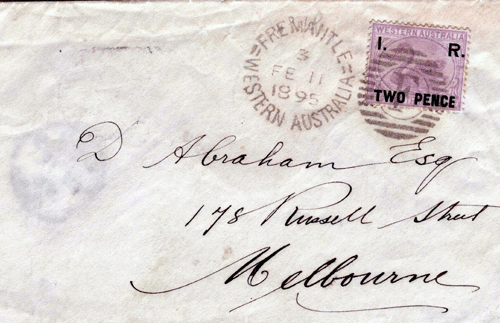
Fig 1
Intercolonial cover paying the correct 2d rate. Short second E in 'pence'
Further into 1881 a new format [fig 2] was sent from De La Rue London. This series ran from 1d to £10, and all are available. There is art work, master dies and die proofs known. Key plate proofs of the frame are also recorded, but none have surfaced. The exhibit must show the inverted watermarks and the ‘specimen’ overprints that are known. Postal use on cover is available and would be a plus.
In 1896 a watermark change with values added to £100. These high values are all to be shown along with inverted watermarks of other values recorded. Essays, plate proofs of the key plates and specimen overprint sets are recorded to £100 in black, a short set to 5/- overprinted in red [fig 2] is believed unique. Postal use on cover is available and would be a plus.
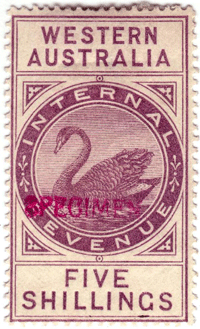
Fig 2
De La Rue 5/- Specimen in Red
The 1897 series continued in the same key type with another watermark change. High values were dropped. The 15/- in this series is a rare beast but only undamaged copies should greatly enhance the exhibit if this is shown as a few damaged ones are recorded. Postal use on cover is available and would be a plus. Plate two is only possible with selvage showing jubilee lines.
Fiscal Postals: De La Rue Postage stamps of 1871-98 were interchangeable for revenue use till December 1900 and a selection of these is a must along with usage, and all are available. Die proofs, plate proofs and specimens should be rewarded.
The 1904 series printed by Waterlow & Sons London: The exhibit must show value frame die proofs [fig 3] first. Each value die proof is unique up to £100 in both the archive book and the shop work book, examples from the shop work book have lesser appeal due to damage. Colour trials of the completed design imperf [frame in brown and swan in blue] overprinted specimen exists with and without punch security hole and both must be shown. Die and plate proofs of the central design [Swan swimming on the Perth River, fig 4] are known in multiples. Specimen overprints to £50 in violet are very rare. File sets to £50 with a 3mm punch hole are plentiful. There is an imperf sheetlet of printers samples separated into two, a vertical strip of the 1, 3d, 6d and a 'block of 6' both exceedingly rare and if shown should be appreciated. There is also a printer’s perforated sample sheet of 6 values available. The series should show values to £100 with some ‘register marks’ clearly represented, again register marks are plentiful and of no great addition.
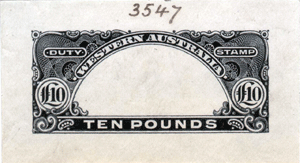
Fig 3
Waterlow Die Proof
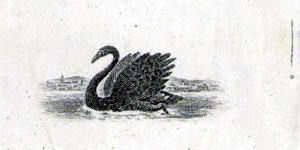
Fig 4
Swan Proof with printers Register Mark
The same format followed from 1906-27, which had an array of colour and perforation changes, with another 13 issues recorded through to 1927. A representative selection with varieties should be shown, such as rare imperf wing margin copies, and imperf between copies found on some values. Shade and perforation studies should be shown. Watermarks are found inverted and sideways and must be shown, with sideways watermark rare. In 1917 an unwatermarked emergency issue of four values was printed. A 2d is recorded by ‘Dzelme’. This is wrong (Elsmore 1998) – no such stamp exists.
In 1941 a new format was issued found on two watermarks. Proofs [fig 5] are recorded of four values and should be shown along with the stamps. The 1951 the design was slightly modified with new watermark paper, and values to £10 were added. Proofs are recorded of two values and should be shown, along with the stamps, including shades. Mould and plate transfer studies in the above are possible.
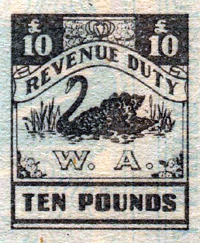
Fig 5
Proof 1941 issue
Colourless embossed duty stamps found on cheques: Three different patterns are known and a selection should be shown.
Impressed duty stamps: 1905 and 1907 values 1d to £100 are plentiful and not at all scarce save for the 11/3d and a good representation should be shown. An 11/3d [fig 6] is recorded by ‘Dzelme’ as never being used. This is wrong – 4 copies are recorded and a copy if shown should be rewarded. Scarlet shades appear scarce and should be shown. Between c.1946 a £200 & £500 value was added to the series and should be shown. The £1000, £2000 and £5000 are only recorded as proofs in private hands several of each are known. A good used selection to £500 should be shown. Plenty of usage is available and should also be shown.
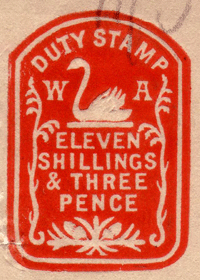
Fig 6
Impressed 11/3d
Highlights to look for:
1. Fiscal/Postal. Postal usage.
2. 1896 £25, £50, £100.
3. 1897 Undamaged 15/-
4. 1904 Waterlow Matrix Die Proof from Archival Book.
5. Central swan design.
6. Printers sample sheet BOTH Imperf and Perforated.
7. 1906-27 sideways and inverted watermarks, imperf wing copies and imperf between.
8. Embossed11/3d.
9. Usage.
10. Essays, die proofs, plate proofs, colour trials and specimen overprints along with perforation and shade studies.
Section Two
This section includes the Supreme Court usage, Income Tax, Beer duty etc. This could either be included in an exhibit along with the De La Rue, Waterloo & Sons and local printings, or would make a very neat three to five frame exhibit on its own.
Supreme Court and Probate Duty overprints: Found on the 1881-03 De La Rue issues [fig 7], all are plentiful.
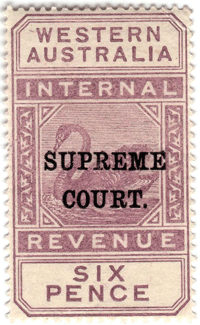
Fig 7
Supreme Court overprint
Fees and Probate: Purpose stamps are found in abundance but genuine used are scarce. A 5/- Fees imperf is known and should be shown.
Government Savings Bank: Proofs and issued stamps should be shown.
Hospital Fund Tax 1930 issue: A 1d to £1 should be shown with usage. Proofs are known and would enhance. A unique set overprinted ‘cancelled’ is known in private hands. In 1940 a new format [nurse] was printed, 1½ to £1 with proofs known to 5/- these are available should be shown.
Financial Emergency
Tax: Issued in 1932-33 1d to £5 all should be
shown. The £5 is found in abundance and not scarce
at all. A unique set overprinted ‘cancelled’ is known in
private hands.
The Joint Commonwealth Tax stamps were introduced [WA printed central] in 1941. 30 values 1d to £5 were printed with 15 only unique die proofs of the frame colours known in private hands and should be well rewarded if shown. Also known with part ‘CANCELLED’ showing one of these groups of letters CAN-CEL-LED. These are from printers booklets sent to interstate tax offices as reference copies, one complete book of values is known another has been exploded and pages should be shown. A ll issued stamps are available with mint being rare only a handful of the £5 exist and would be a plus if shown. Usage is particularly rare with the £5 very rare. A £5 essay [fig 8] is known beware of copies and if shown should be carefully examined.
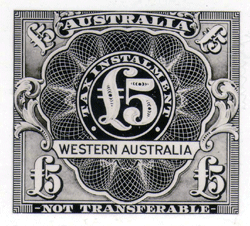
Fig 8
Essay
Pig Industry Compensation stamps of 1943: A 1d to 10/- and a 2d on 3d should be shown, along with proofs.
Beef Cattle Industry Compensation Fund: These overprints on the 1d adhesive of 1951 are known and were issued in 1964. A selection of these should be shown. All are scarce.
Betting Tickets: Would help enhance an exhibit with full tickets given a plus.
Entertainment Tax: Proofs and issued tickets are available.
Egg Stabilisation Charge: Mint remainders are available, printed in 1940 these have two dies which should be explained by the exhibitor, genuine used stamps are scarce.
Beer Duty: Mint remainder copies
are known and a selection should be shown, genuine used
stamps are very rare and should be rewarded. An exhibit
not showing ant beer duties should be penalised as
remainders are available.
Highlights to look for:
1. Supreme Court and Probate overprints on the 1881-03 De La Rue issues.
2. Income Tax 1941
3. Beer Duty issues are a must to be shown.
4. Usage.
5. Essays, die proofs, plate
proofs, colour trials and specimen overprints along with
perforation and shade studies.
All in
all Western Australian Revenues are the most
available to the collector with thousands regularly
up for auction. Also the most exhibited of all the
Australian States with several 8 frame Gold or
better exhibits existing. This should be taken into
account when evaluating the 'how hard is this state
to replicate', answer: quite easy.
I would strongly recommend to all revenue judges to reread the FIP GREX and SREV’s before attempting to evaluate a revenue exhibit and adhere to them. Exhibitors tend to increase the size of their exhibit over a period of time as material is sourced and added to frame by frame. If an exhibit has been rewritten, do not evaluate the exhibit on past showings. Evaluate the exhibit on what you see in the frames before you.
Revenues as a new class lacks published information and simple sources for obtaining material. Thus original research and the problem of acquisition of unusual material is more difficult than in more traditional classes. This should be appreciated by the judges.
Write critiques to help the exhibitor further his exhibit. Straight negative critiques are unhelpful at the best of time, but even worse for a new field such as revenues.
Treatment is left to the judge’s expertise with the exhibitor following the FIP SREV’s which can be found at the FIP web site here: https://www.f-i-p.ch/ The writer can be contacted at this email address: Dave
© copyright 1997 on
All Graphics. Dave Elsmore
No part of this page may be copied used, saved in electronic form or hard printed.